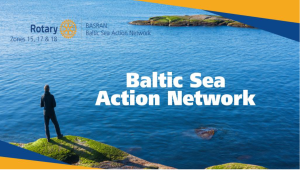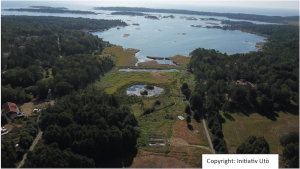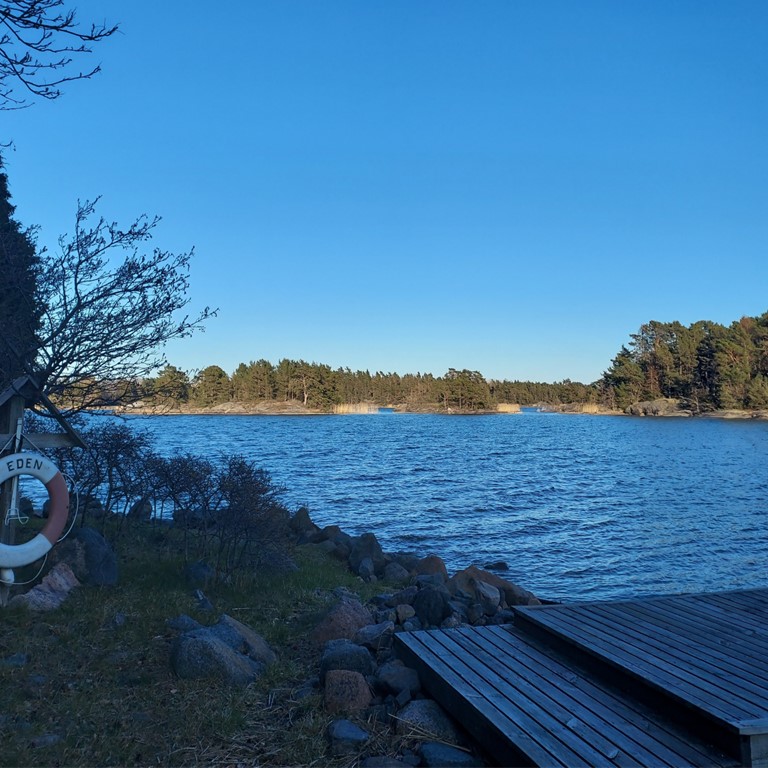by Päivi Kippo-Edlund, ESRAG Director
While watching birds with my binoculars by the Baltic Sea, I´m thinking about the 2023 High Seas Treaty, and how important it is to protect high seas ecosystems, habitats and species. For me, protecting the Baltic Sea is an issue of my heart. I took the photograph of the Baltic, here, from the window of my summer house.

The Baltic Sea is an arm of the Atlantic Ocean that is enclosed by Denmark, Estonia, Finland, Germany, Latvia, Lithuania, Poland, Russia and Sweden. The Baltic Sea is among the most polluted seas in the world, even though many achievements in environment protection have made its state better over the last few decades.
There are inner seas, rivers, lakes and other bodies of water almost everywhere in the world. Their catchment areas are far wider than these bodies of water themselves. Every measure taken to decrease the emissions of nutrients and harmful chemicals in the catchment areas influences the state of the body of water they lead to. Decreased nutrient loads have a positive effect on climate change too.
The High Seas Treaty is an agreement on protecting marine biodiversity in international waters. It was adopted by the delegates of the United Nations in March. The Treaty is a monumental and historic win to ocean protection and a sign of mutual will of the nations. The Treaty would put more money into marine conservation and use of marine genetic resources. As UN Secretary General Antonio Guterres explains, the treaty is crucial for addressing the triple planetary crisis of climate change, loss of biodiversity, and pollution.
From Finland, I am writing to share with you some of the ways Rotarians from the Baltic Region are working to protect our inland sea, and how we can help this treaty succeed.
The High Seas Treaty keeps the target of conserving 30% of the world’s oceans alive by 2030. The United Nations Biodiversity Conference (COP 15) adopted this target as a part of the Kunming-Montreal Global Biodiversity Framework (GBF) in December 2022. The Treaty sets the goal of creating fully or highly protected areas across the world’s oceans. The agreement also says that activities in the high seas will be subject to environmental impact assessments. There will be a Scientific and Technical body established that will be instrumental in ensuring that proposals and management plans for marine protected areas are rigorously evaluated, and the environmental impact assessment reports are made accessible to the global community.
Governments all over the world have to ratify and put the Treaty into practice in an effective way. Only after that will the Ocean Treaty will have real impact.
Why protect the high seas? The world’s oceans cover approximately 71% of the Earth and contain 97% of the water on the Earth. Acting as an enormous heat reservoir, the ocean influences climate and weather patterns, the carbon cycle, and the water cycle. Photosynthesis by plants and free-floating phytoplankton creates 50% of the oxygen that animals including humans breathe.
The high seas provide habitats for hundreds of thousands of species. The high seas mitigate the impacts of global warming: 23% of the human-generated greenhouse gas emissions have been absorbed by the ocean over the last ten years. This slows global warming, but it also leads to acidification, with disastrous consequences for marine ecosystems. Approximately 25% of known species in the high seas are already threatened with extinction.
The ocean is subject to human-caused environmental threats, including marine pollution, overfishing, rising ocean temperatures, ocean acidification and sea-level rise. The coastal waters that are most influenced by human activity are especially vulnerable. Actions aimed at combating climate change, decreasing the inputs of nutrients and hazardous chemicals, and preserving biodiversity are linked. We need a holistic approach to protecting the seas.
How Rotarians can act to protect the seas: Environment is one of Rotary International’s key focus areas. Rotarians can help by raising awareness and taking responsibility for protecting oceans and seas. Environment should be on the agenda of Governor- Elect Training Seminars. Districts should advocate with their governments for swift ratification of the Ocean Treaty so actions to protect the high seas can start. The Environmental Sustainability Action Group (ESRAG) acts as a catalyst for the districts and clubs in their environmental projects. ESRAG should give more emphasis to protecting oceans and seas.
Best practices of Rotary action to protect the seas: The Baltic Sea Regional Action Network (BASRAN) is a network of Rotarians established in Finland by D1420 and D1410 in 2019. The goal is to connect Rotarians around the Baltic Sea in all nine coastal countries around the Baltic in a joint initiative. BASRAN acts as coordinating body to help Clubs and Districts to focus their activities aiming at protecting the sea.
BASRAN’s way of working could be scaled up in other parts of the world wherever there is an inner sea or great lakes. Read more here.
 There are different kinds of projects going on in the Baltic Sea countries under the umbrella of BASRAN.
There are different kinds of projects going on in the Baltic Sea countries under the umbrella of BASRAN.

Rotarians’ 2022 blue-green algae observing sites. Map provided by Finnish Environment Institute (SYKE)
Project Blue Green Algae Monitoring (Finland): Massive blue-green algae blooms in the surface layer of the sea are an indicator of excessive nutrients in the water. Finnish Rotary is cooperating with the Finnish Environment Institute as part of the monitoring of the blue green algae situation along the coasts of the Baltic Sea and lakes. This is citizen science. Last summer more than 80 clubs with approximately 200 Rotarians took part in the project. Rotarians made observations and put the results in a digital register of the Finnish Environment Institute. The project started 2020 and is ongoing.

A Swedish wetland – photo credit, Initiativ Üto
Initiativ Utö (Sweden): Utö is a small island in the Stockholm Archipelago. Swedish Rotarians are working with Inititiav Utö to restore wetlands, a good example of nature-based solutions. The European Commission defines nature-based solutions as cost-effective solutions that are inspired and supported by nature, simultaneously provide environmental, social and economic benefits, and help build resilience. Initiativ Utö has developed and manages three wetlands. Together with KTH (Royal Institute of Technology) Initiativ Utö has developed a model for how to restore the Baltic Sea to balance. Three wetlands can become three thousand. Or more!
ESRAG’s Every Club Climate Friendly Initiative was launched earlier this year, to connect and aid clubs working to exemplify and expand climate responsibility.
The priorities are to:
- Increase Rotary´s global impact by taking actions in your club to mitigate climate change.
- Expand our reach to those who are already acting on climate change. Imagine the new partnerships in your community.
- Engage in carbon emission reductions and nature-based solutions such as mangrove restoration, wetland restoration, tree planting, and sustainable agriculture
- Align our investments with the environment area of focus in order to save future generations
Author: Päivi Kippo-Edlund, MSc (biology) Director, ESRAG Board of Directors ESRAG Europe Management Team. Past President, Porvoo läntinen-Borgå västra RC. Chair, District 1420 International Service Committee
